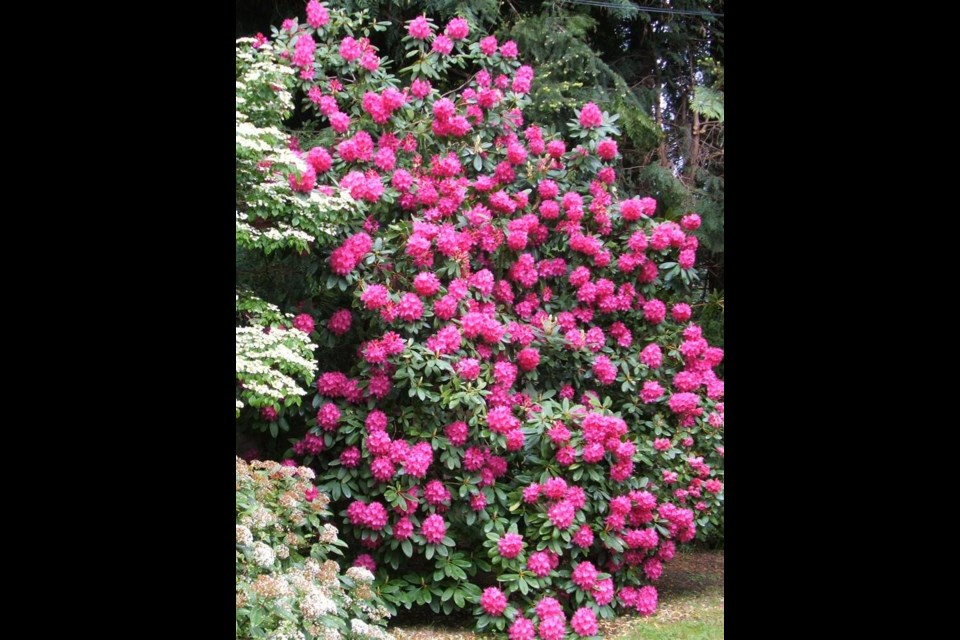Dear Helen: In the spring, as newcomers to the coast we became fascinated by all the beautiful rhododendrons we saw. We’ve noticed them in many different types of sites and wonder whether the shrubs are at all fussy about their growing conditions.
B.L.
To grow and bloom really well over the long term, rhododendrons do have a few basic needs. One is for a humus-rich, spongy, acid soil that retains moisture well but drains efficiently of excess water.
Dense shade will limit flowering. Rhododendrons grow and bloom best in filtered light or dappled shade, with shelter from the hottest afternoon summer sun. Large-leaved rhododendrons are most vulnerable to drying and burning in full sun.
Most rhododendrons have their origins in areas with rainy summers. Regular summer watering is essential. A fresh mulch layer of compost and/or fine fir bark placed under and around the plants as the weather warms in spring is helpful too in protecting the shrubs’ shallow roots. Water well first, and keep mulching materials away from the base of the shrub (where top growth meets the roots).
Dear Helen: How early in the year can I safely seed carrots and beets? What might happen if I seed too early? I’m wondering, too, about broad beans and shelling peas.
V.P.
Weather and soil conditions permitting, broad beans can be sown outdoors in February. This is a very hardy, cool season bean.
The next major seeding I make, in March, is the shelling peas, followed closely by carrots and beets. I plant enough of these three vegetables to last me for close to a year.
A very early planting of biennial vegetables can lead to a premature bolting to seed. Biennial plants produce roots and leafy growth in their first year and, after the cold of winter, flower stems and seeds in the second year. Beets, carrots, leeks, onions and cabbage are biennials.
A period of cold weather following an early seeding (or transplanting, as in onions and leeks) can simulate winter and trigger young plants into “bolting” to seed.
I’ve not yet observed any bolting in my beets and carrots seeded in March, but I sometimes have one or two leek transplants produce flower stalks in their first year.
As this year’s growing season has shown, we can no longer be certain that traditional weather patterns on the Island will continue. In particular, the “heat dome” of late June and early July will be remembered, and perhaps serve as a prompt toward even earlier planting of vegetables that prefer cool growing conditions.
For the short season ones, like radishes, spinach, lettuce and endive, early planting gives the best chance of harvesting useable food before it fries in the heat. For longer-season edibles like beets and carrots, an early seeding gives the plants a good chance to be sized up and established enough to withstand fierce heat.
Dear Helen: When is the best time and the easiest way to take and root cuttings from fuchsias?
C.D.
Stem tip cuttings are, for most people, the easiest propagation method. The cuttings can be taken from late spring to late summer, with early summer considered the ideal timing. At this point, soft tip growth has become slightly firm and easy to handle.
Choose healthy looking stem tips and make the cutting around eight cm long, with the base cut immediately below a leaf joint. Remove the lowest leaves and the soft stem tips and insert the cuttings in pre-made holes in a lightweight potting mix. Firm them in gently, water, and set the container in warmth and good light but out of direct sun.
Arrange a loose, clear plastic “humidity tent” over and around the cuttings while they root. New growth indicates the cuttings have rooted. Uncover them and pot the cuttings individually. As they develop, pinch out the growing tips to induce bushiness.
Remembrance at Abkhazi. Abkhazi Garden, 1964 Fairfield Rd. in Victoria, will be open on Remembrance Day tomorrow, from 11 a.m. to 3:30 p.m. Prince Nicolas and Princess Peggy Abkhazi were both interned during the second world war. After the war they reunited and settled in Victoria, where they established the landscape known as “the garden that love built.” It is also a garden that celebrates peace. Free small group tours of the garden will be available. Admission is by donation. The Teahouse will be open for reservations. . 778-265-6466.



